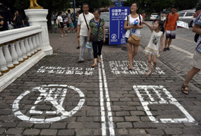 Vintage cars show kicks off in London
Vintage cars show kicks off in London
 Gorgeous scenery in NE China
Gorgeous scenery in NE China
 Picturesque Barkol grassland in Xinjiang
Picturesque Barkol grassland in Xinjiang
 Small Wild Goose Pagoda - A World Cultural Heritage Site along the Silk Road
Small Wild Goose Pagoda - A World Cultural Heritage Site along the Silk Road
 Maritime Silk Road Luxuries of the Han Dynasty
Maritime Silk Road Luxuries of the Han Dynasty
 Ciao! Chinese beauties!
Ciao! Chinese beauties!
 An eye feast: BFA freshmen registration
An eye feast: BFA freshmen registration
 Top 10 most lavish weddings
Top 10 most lavish weddings
 Most amazing chi-pao beauties
Most amazing chi-pao beauties
 Chinese lingerie brand arrives in Las Vegas
Chinese lingerie brand arrives in Las Vegas
A new term that is becoming known to more and more people is "new normal." As the Chinese economy has entered a "new normal" phase, what has changed includes policy, industrial structure and official mindsets, as well as the daily lives of ordinary people.
Prices: foodstuffs more affordable; consumption goes up
Though facing greater downside economic pressure as we traverse 2014, expenditure from central finance on standards of living has increased rather than decreased. Investment has made great progress in fields like tax relief of small and micro enterprises, urban and rural infrastructure, education, health care and social security reform.Benefiting from the low and stable prices that have kept inflation below 2.5%, citizens have more choice in areas such as dining and shopping, leisure and tourism, films and reading.
However, new problems must also be faced.
From the investment-led economic model to the development strategy of expanding consumption, people will get used to the "new normal" that generates more consumer spending.
Experts point out that factors like price reform of basic products, and demographic changes brought by rising labor costs, can be the reasons for price inflation.
There will be more challenges to deal with for the "new normal".
Employment: blowout in venture, shrinking needs in traditional industries
With economic growth slowing, will the job market be affected? Under economic restructuring, will workers lose their jobs? With mass stimulus policies canceled, will the unemployment rate rise?
Actually, through decentralization, directional control, and fiscal-positive policies in relevant industries, the entrepreneurial environment remains rock solid.
Entrepreneurship to create jobs has become part of the landscape. Data shows that newly registered enterprises boomed in the first half of this year. The number of newly registered enterprises hit 1.68 million, an increase of 57%, of which 1.58 million were private enterprises. Meantime, the number of employees reaches over 10 million, an increase of 43%.
During the 2014 Summer Davos Premier Li Keqiang revealed that as of August, urban employment this year lay around 10 million, close to the annual target.
But it should not be ignored that structural contradictions still exist in employment, with job needs shrinking in traditional industries and talent not yet meeting the demand in new technology industries.
Same buildings , different real estate
To buy or not to buy is the question that bothers hundreds of thousand families. The iron law that the buyer always gains has been repeatedly confirmed, and seems to be coming true yet again.
Although the government rarely made it clear towards real estate regulation after taking office for more than a year, it increased investment in affordable housing projects and rebuild of shantytowns.
When the buildings keep coming up along with the fluctuations in supply and demand balance, the situation in the real estate marekt has changed silently.
How to avoid excessive fluctuantions and a hard landing?
Providing appropriate regulations for differnt categories, affordable housing provides a cushion. This is the new solution that come up with by the decision-makers.
 Giant white gourd weighing 87 kilograms appears in SE China
Giant white gourd weighing 87 kilograms appears in SE China Advanced arms help to safeguard China-ASEAN Expo
Advanced arms help to safeguard China-ASEAN Expo Leading director Wang Quan'an detained for 'buying sex'
Leading director Wang Quan'an detained for 'buying sex' Heaven on earth: Dongjiang Lake in Hunan
Heaven on earth: Dongjiang Lake in Hunan Mixed reaction to smartphone sidewalk
Mixed reaction to smartphone sidewalk 'Rainbow running' race in Jiangxi
'Rainbow running' race in Jiangxi Amazing aerial photos of China's Xisha Islands
Amazing aerial photos of China's Xisha Islands Beautiful postgraduate teaches in remote area
Beautiful postgraduate teaches in remote area Top 10 world's highest-paid models 2014
Top 10 world's highest-paid models 2014 Lingerie show at 2014 Miss China
Lingerie show at 2014 Miss China Songstress Li Xianglan dies at 94
Songstress Li Xianglan dies at 94 Police recruiting posters
Police recruiting posters Anshun Daxi- Living fossil of Chinese drama
Anshun Daxi- Living fossil of Chinese drama Urban farmers in China
Urban farmers in China 'Firepower-2014 Weibei'military exercise
'Firepower-2014 Weibei'military exerciseDay|Week|Month